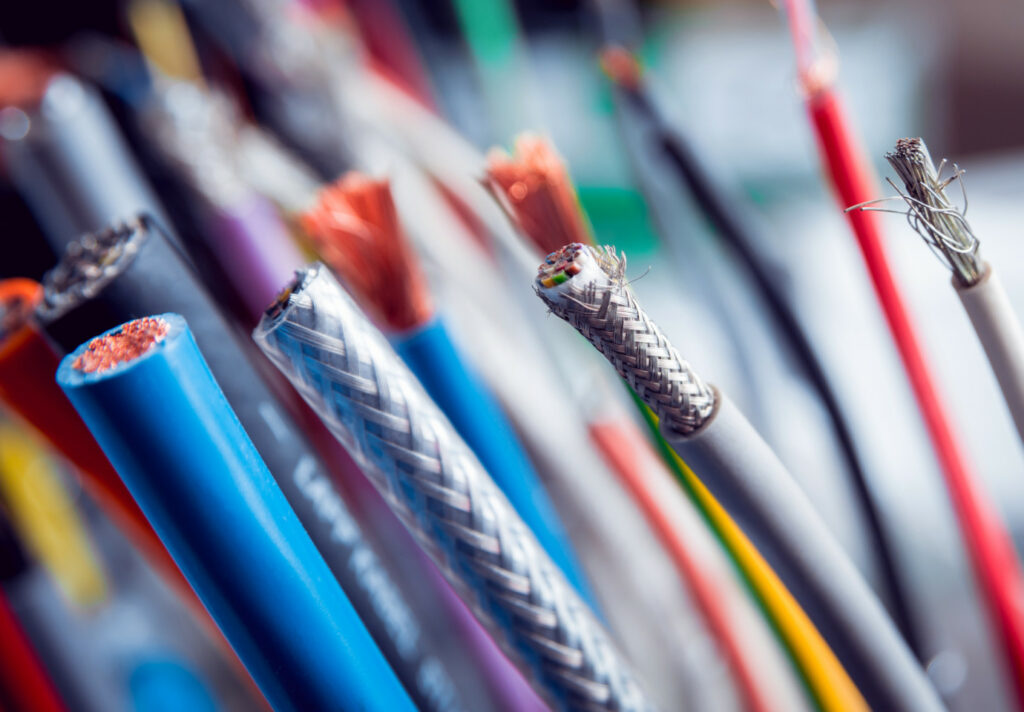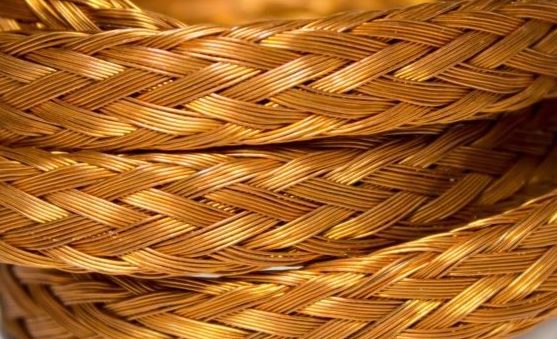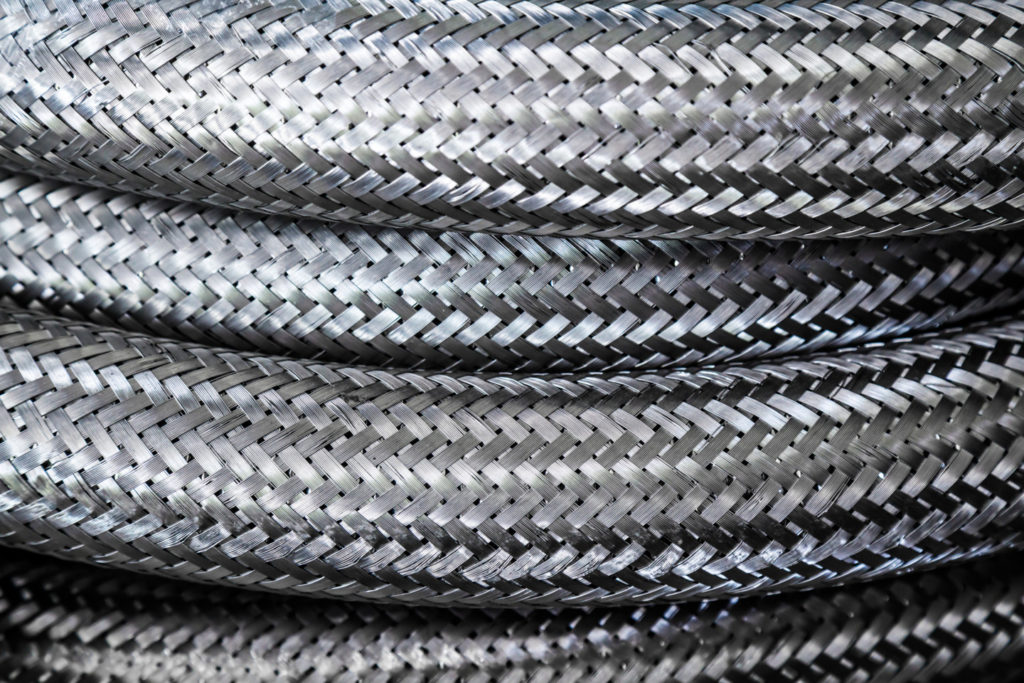Braiding and Braid Assemblies
Strong, Pliable, and Durable Wire Solutions
Available in wire
Wire braiding involves interweaving multiple strands of wire to create strong, flexible, and durable wire products, such as cables and hoses. Braided wire products are crucial for a number of industry sectors, including aerospace, automotive, electronics, medical, and telecommunications. The Knight Group’s dedicated wire division has an impressive wire processing capability, offering custom braided wire solutions in a wide range of materials.
Braided Wire Specifications
Wire braiding is a process where multiple strands of wire are interwoven to create a flexible, strong, and durable wire product. The woven end result offers distinct advantages over single strand wire, which becomes less flexible as diameter increases and is more susceptible to failure in applications where a range of movement is required. This technique is commonly used in the manufacturing of cables, hoses, and other products that require strength, flexibility, and resistance to abrasion.
Wire braiding is typically done using specialised braiding machines, using spools rapidly spinning in circular motions as they intertwine the wire strands in a precise pattern. The result is a round wire braid, however, braid protection uses the same process, braiding a protective layer over the underlying core. The process can be fully automated or semi-automated, depending on the specific requirements of the product.
Wire braid sizes are ultimately dictated by the number of carriers in a machine. Commonly, a braiding machine has 16, 24, or 48 carriers. Each carrier is equipped with a bobbin that can hold anywhere from one to sixteen strands of wire, or even more, depending on the machine’s capacity. To determine the number of carriers and wires per carrier used to create a specific braid, one can examine the construction information provided in the braid specifications. The construction is typically denoted by three values e.g. 24-10-0.2.
- 24 = The number of carriers
- 10 = The number of wires per carrier
- 0.2 = diameter in mm (sometimes given as wire gauge such as SWG,AWG)
Our dedicated wire division, Knight Precision Wire, has an extensive range of braiding machines catering for small and large order quantities with short lead times. We have over 10 machines offering a wider carrier range than industry standards, including 8,12,16,24,36 and 48 carriers. This extended range ensures fully customisable solutions to cater for all manufacturing needs.
We typically braid copper, tinned copper and stainless steel but can offer wire braiding in most alloys we supply, including aluminium, titanium and nickel alloys. See our full range of supplied alloys here. We also work with a range of textiles, including cotton, kevlar and more, ideal for a variety of braid protection needs.
The size range of wire is between 0.1mm up to 0.4mm.
Our braided wire can be supplied on spools or terminated cut to lengths to meet your requirements



Braid Types
Braided wire, a versatile and durable material, has a long history dating back to ancient civilisations, where it was used for decorative and functional purposes. Today, braided wire plays a crucial role in the world of electrical engineering, providing strength, flexibility, and protection to various electrical components and systems. They are used in a wide range of applications, from cable shielding to grounding straps and conductive connectors, making them an essential component in many sectors, including aerospace, automotive, medical and telecommunications.
There are several types of braided wire available, each suited for specific applications:
Round braid: Characterised by its symmetrical and balanced design, round braid is commonly used as conductive connectors in high-temperature environments or applications requiring strength, flexibility, and conductivity.
Flat braid: Flat braid is created when a round wire braid is flattened with a pressure roller. A flat braid provides the same level of strength and flexibility as a round braid; however, the increase in surface area results in lower resistance when electricity passes through it. With its flat cross-section, flat braid is often used for grounding straps and cable shielding, providing effective protection against electromagnetic interference (EMI) and radio frequency interference (RFI).
Spiral braid: Featuring a spiral design wrapped around a core, spiral braid is ideal for cable shielding, offering high coverage and flexibility.
We also specialize in the over-braiding of customer supplied hoses or cables to suit the end application. This is most typically used for external protection and for reinforcement.
Knight Precision Wire offers a variety of wire services and can provide free quotations on your requirements. Please get in touch to arrange this.
Benefical Properties of Braided Wire
Braided wire offers several unique properties that make it stand out from other types of wire:
Enhanced Flexibility and Strength: Due to its woven structure, braided wire combines strength and high flexibility, allowing it to bend and flex without breaking or losing its electrical conductivity. This makes it ideal for applications where movement or vibrations are present.
Excellent Protection Against Electromagnetic Interference (EMI): The interwoven design of the wire creates a shielding effect that helps to reduce the impact of EMI on the electrical signals and ensures electronic devices maintain their signal integrity and function optimally, even in environments with high levels of electromagnetic noise.
Improved Resistance to Abrasion and Wear: The woven structure of the wire provides a robust and durable outer layer that protects the inner conductors from damage caused by friction, rubbing, or impact, maintaining its electrical performance and integrity over time.
Aesthetic Appeal: The intricate, woven pattern of the wire creates a visually pleasing appearance that can enhance the overall design of electronic devices or installations. Brading is available in various materials, colours, and finishes, allowing for customisation and coordination with other components or design elements.
Applications and Advantages of Braided Wire in the Electronics Industry
In the electronics industry, braided wire is used in various applications, offering several advantages over other types of wire:
Cable shielding: Braided wire, particularly flat and spiral braids, provides excellent protection against EMI and RFI, ensuring signal integrity in sensitive electronic devices.
Grounding straps: Flat braids are commonly used as grounding straps, offering a secure and reliable electrical connection between electronic components.
Flexible connectors: Round braids are often used as conductive connectors in high-temperature environments or applications requiring a balance of strength, flexibility, and conductivity.
Wire harnesses: Due to its flexibility and durability, braided wire is ideal for use in wire harnesses, which are used to organize and protect wiring in electronic devices.
Braided Wire and Overbraiding FAQ
Wire braiding, also known as braided wire, is a technique used in various industries to create strong, flexible, and durable wire products.
We hope this comprehensive FAQ guide will answer all your questions about wire braiding and overbraiding. If you require further assistance or would like to place an order, you can use our contact form, 01707 645261 or wire.sales@knight-group.co.uk.
Wire braiding is a process where multiple strands of wire are interwoven to create a flexible, strong, and durable wire product. This technique is commonly used in the manufacturing of cables, hoses, and other products that require strength, flexibility, and resistance to abrasion.
Some of the key benefits of wire braiding include:
- Increased strength and durability
- Enhanced flexibility
- Improved resistance to abrasion and wear
- Better protection against electromagnetic interference (EMI)
- Aesthetic appeal
Wire braiding can be done with various materials, including:
- Copper
- Stainless steel
- Aluminum
- Tinned copper
The choice of material depends on the specific application and desired properties of the finished product.
To see our full range of alloy, please click here.
There are three main types of wire braiding:
- Round braid: A symmetrical and balanced braid with a round cross-section
- Flat braid: A braid with a flat cross-section, often used for grounding straps and cable shielding
- Spiral braid: A braid that spirals around a core, often used for cable shielding
Wire braiding is typically done using specialized braiding machines that interweave the wire strands in a precise pattern. The process can be fully automated or semi-automated, depending on the specific requirements of the product.
Wire braiding is used in various industries, including:
- Aerospace
- Automotive
- Electronics
- Medical
- Telecommunications
While both wire braiding and wire twisting involve interweaving multiple strands of wire, they differ in the specific patterns used and the resulting properties of the finished product. Wire twisting typically results in a more rigid and less flexible product, while wire braiding creates a more flexible and durable product.
Yes, wire braiding can be done with a combination of different materials to achieve specific properties or aesthetic effects. For example, a braided wire product may use copper and stainless steel wires to combine the electrical conductivity of copper with the strength and corrosion resistance of stainless steel.
To choose the right wire braid for a specific application, consider factors such as:
- The required strength and durability
- The desired flexibility
- The level of protection against abrasion, wear, and EMI
- The specific materials and their properties
- The intended use and environmental conditions
To maintain and care for braided wire products, follow these tips:
- Inspect the product regularly for signs of wear or damage
- Keep the product clean and free from dirt and debris
- Avoid exposing the product to harsh chemicals or extreme temperatures
- Where possible, store in a dry, cool, and well-ventilated area
Overbraiding refers to the process of weaving a protective layer of braided material, such as wire, fibers, or yarn, over a cable, hose, or conduit. This technique is used to enhance the mechanical strength, durability, and protection of the underlying cable or hose. The braided layer can be made from various materials, including metal (such as copper or stainless steel), synthetic fibers (like polyester or kevlar), or natural fibers (e.g. cotton).
In the electronics industry, overbraiding is often used to provide cable shielding, which helps protect cables from electromagnetic interference (EMI) and radio frequency interference (RFI). The braided layer can also improve the cable’s resistance to abrasion, wear, and environmental factors, such as moisture, chemicals, or temperature fluctuations.
In addition to its functional benefits, overbraiding also offers aesthetic appeal. Available in various materials, colors, and finishes, the intricate, woven pattern of the outer layer creates a visually pleasing appearance that can enhance the overall design the product We offer complete customisation in our braiding options, enabling coordination with other components or design elements. This aesthetic appeal can be particularly important in consumer electronics or other applications where aesthetics play a significant role in the user experience or product perception.
Knight Precision Wire are specialist wire and cable manufacturers and can provide free quotations based on your requirements. You can use our contact form, 01707 645261 or wire.sales@knight-group.co.uk.
All data is provided for informational purposes only. In no event will the Knight Group and its subsidiaries, be liable for in respect of any action taken by any third party arising from using the information taken from our online or printed sources. Chemical and Mechanical Properties should not be construed as maximum or minimum values for specifications, nor should information be used to assess suitability for a particular use or application. The information and data provided is deemed to be accurate to the best of our knowledge and may be revised anytime without notice and assume no duty to update